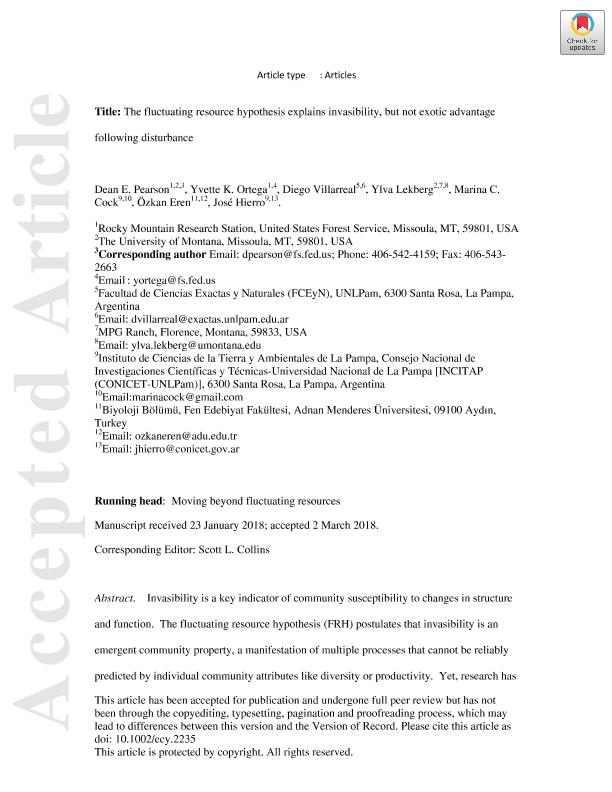Artículo
The fluctuating resource hypothesis explains invasibility, but not exotic advantage following disturbance
Pearson, Dean; Ortega, Yvette K.; Villarreal, Diego; Lekberg, Ylva; Cock, Marina Cecilia ; Eren, Ozkan; Hierro, Jose Luis
; Eren, Ozkan; Hierro, Jose Luis
 ; Eren, Ozkan; Hierro, Jose Luis
; Eren, Ozkan; Hierro, Jose Luis
Fecha de publicación:
06/2018
Editorial:
Ecological Society of America
Revista:
Ecology
ISSN:
0012-9658
Idioma:
Inglés
Tipo de recurso:
Artículo publicado
Clasificación temática:
Resumen
Invasibility is a key indicator of community susceptibility to changes in structure and function. The fluctuating resource hypothesis (FRH) postulates that invasibility is an emergent community property, a manifestation of multiple processes that cannot be reliably predicted by individual community attributes like diversity or productivity. Yet, research has emphasized the role of these individual attributes, with the expectation that diversity should deter invasibility and productivity enhance it. In an effort to explore how these and other factors may influence invasibility, we evaluated the relationship between invasibility and species richness, productivity, resource availability, and resilience in experiments crossing disturbance with exotic seed addition in 1-m2 plots replicated over large expanses of grasslands in Montana, USA and La Pampa, Argentina. Disturbance increased invasibility as predicted by FRH, but grasslands were more invasible in Montana than La Pampa whether disturbed or not, despite Montana´s higher species richness and lower productivity. Moreover, invasibility correlated positively with nitrogen availability and negatively with native plant cover. These patterns suggested that resource availability and the ability of the community to recover from disturbance (resilience) better predicted invasibility than either species richness or productivity, consistent with predictions from FRH. However, in ambient, unseeded plots in Montana, disturbance reduced native cover by >50% while increasing exotic cover >200%. This provenance bias could not be explained by FRH, which predicts that colonization processes act on species? traits independent of origins. The high invasibility of Montana grasslands following disturbance was associated with a strong shift from perennial to annual species, as predicted by succession theory. However, this shift was driven primarily by exotic annuals, which were more strongly represented than perennials in local exotic vs. native species pools. We attribute this provenance bias to extrinsic biogeographic factors such as disparate evolutionary histories and/or introduction filters selecting for traits that favor exotics following disturbance. Our results suggest that (1) invasibility is an emergent property best explained by a community´s efficiency in utilizing resources, as predicted by FRH but (2) understanding provenance biases in biological invasions requires moving beyond FRH to incorporate extrinsic biogeographic factors that may favor exotics in community assembly.
Archivos asociados
Licencia
Identificadores
Colecciones
Articulos(INCITAP)
Articulos de INST.D/CS D/L/TIERRA Y AMBIENTALES D/L/PAMPA
Articulos de INST.D/CS D/L/TIERRA Y AMBIENTALES D/L/PAMPA
Citación
Pearson, Dean; Ortega, Yvette K.; Villarreal, Diego; Lekberg, Ylva; Cock, Marina Cecilia; et al.; The fluctuating resource hypothesis explains invasibility, but not exotic advantage following disturbance; Ecological Society of America; Ecology; 99; 6; 6-2018; 1296-1305
Compartir
Altmétricas



